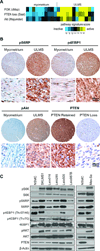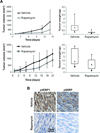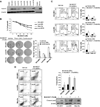Dual targeting of mTOR and aurora-A kinase for the treatment of uterine Leiomyosarcoma
- PMID: 22821997
- PMCID: PMC3432751
- DOI: 10.1158/1078-0432.CCR-12-0436
Dual targeting of mTOR and aurora-A kinase for the treatment of uterine Leiomyosarcoma
Abstract
Purpose: The significance of mTOR activation in uterine leiomyosarcoma (ULMS) and its potential as a therapeutic target were investigated. Furthermore, given that effective therapies likely require combination mTOR blockade with inhibition of other targets, coupled with recent observations suggesting that Aurora-A kinase (Aurk-A) deregulations commonly occur in ULMS, the preclinical impact of dually targeting both pathways was evaluated.
Experimental design: Immunohistochemical staining was used to evaluate expression of activated mTOR components in a large (>200 samples) ULMS tissue microarray. Effects of mTOR blockade (using rapamycin) and Aurk-A inhibition (using MLN8237) alone and in combination on human ULMS cell growth, cell-cycle progression, and apoptosis were assessed in cellular assays. Drug interactions were determined via combination index analyses. The antitumor effects of inhibitors alone or in combination were evaluated in vivo.
Results: Enhanced mTOR activation was seen in human ULMS samples. Increased pS6RP and p4EBP1 expression correlated with disease progression; p4EBP1 was found to be an independent prognosticator of patient outcome. Rapamycin inhibited growth and cell-cycle progression of ULMS cell strains/lines in culture. However, only a cytostatic effect on tumor growth was found in vivo. Combining rapamycin with MLN8237 profoundly (and synergistically) abrogated ULMS cells' growth in culture; interestingly, these effects were seen only when MLN8237 was preadministered. This novel therapeutic combination and scheduling regimen resulted in marked tumor growth inhibition in vivo.
Conclusions: mTOR and Aurk-A pathways are commonly deregulated in ULMS. Preclinical data support further exploration of dual mTOR and Aurk-A therapeutic blockade for human ULMS.
©2012 AACR.
Conflict of interest statement
Figures






Similar articles
-
A small-molecule inhibitor targeting the mitotic spindle checkpoint impairs the growth of uterine leiomyosarcoma.Clin Cancer Res. 2012 Jun 15;18(12):3352-65. doi: 10.1158/1078-0432.CCR-11-3058. Epub 2012 Apr 25. Clin Cancer Res. 2012. PMID: 22535157 Free PMC article.
-
Constitutive activation with overexpression of the mTORC2-phospholipase D1 pathway in uterine leiomyosarcoma and STUMP: morphoproteomic analysis with therapeutic implications.Int J Clin Exp Pathol. 2010 Jan 28;4(2):134-46. Int J Clin Exp Pathol. 2010. PMID: 21326806 Free PMC article.
-
Combining EGFR and mTOR blockade for the treatment of epithelioid sarcoma.Clin Cancer Res. 2011 Sep 15;17(18):5901-12. doi: 10.1158/1078-0432.CCR-11-0660. Epub 2011 Aug 5. Clin Cancer Res. 2011. PMID: 21821699 Free PMC article.
-
Recent advancements in mechanistic research, therapeutic potential, and structure-activity relationships of aurora kinase inhibitors in cancer therapies.Bioorg Chem. 2025 Jan;154:107976. doi: 10.1016/j.bioorg.2024.107976. Epub 2024 Nov 16. Bioorg Chem. 2025. PMID: 39603069 Review.
-
Status of the Current Treatment Options and Potential Future Targets in Uterine Leiomyosarcoma: A Review.Cancers (Basel). 2022 Feb 24;14(5):1180. doi: 10.3390/cancers14051180. Cancers (Basel). 2022. PMID: 35267488 Free PMC article. Review.
Cited by
-
Issues in interpreting the in vivo activity of Aurora-A.Expert Opin Ther Targets. 2015 Feb;19(2):187-200. doi: 10.1517/14728222.2014.981154. Epub 2014 Nov 11. Expert Opin Ther Targets. 2015. PMID: 25384454 Free PMC article. Review.
-
The role of adjuvant therapy in uterine leiomyosarcoma.Expert Rev Anticancer Ther. 2016;16(1):45-55. doi: 10.1586/14737140.2016.1115724. Epub 2015 Nov 26. Expert Rev Anticancer Ther. 2016. PMID: 26558647 Free PMC article. Review.
-
Targeting AURKA in Cancer: molecular mechanisms and opportunities for Cancer therapy.Mol Cancer. 2021 Jan 15;20(1):15. doi: 10.1186/s12943-020-01305-3. Mol Cancer. 2021. PMID: 33451333 Free PMC article. Review.
-
An immunohistochemical analysis of stathmin 1 expression in uterine smooth muscle tumors: differential expression in leiomyosarcomas and leiomyomas.Int J Clin Exp Pathol. 2015 Mar 1;8(3):2795-801. eCollection 2015. Int J Clin Exp Pathol. 2015. PMID: 26045786 Free PMC article.
-
Thy-1+ Cancer-associated Fibroblasts Adversely Impact Lung Cancer Prognosis.Sci Rep. 2017 Jul 25;7(1):6478. doi: 10.1038/s41598-017-06922-5. Sci Rep. 2017. PMID: 28744021 Free PMC article.
References
-
- Schwartz LB, Diamond MP, Schwartz PE. Leiomyosarcomas: clinical presentation. Am J Obstet Gynecol. 1993;168:180–183. - PubMed
-
- Smith DC, Macdonald OK, Lee CM, Gaffney DK. Survival impact of lymph node dissection in endometrial adenocarcinoma: a surveillance, epidemiology, and end results analysis. Int J Gynecol Cancer. 2008;18:255–261. - PubMed
-
- Zivanovic O, Leitao MM, Iasonos A, Jacks LM, Zhou Q, Abu-Rustum NR, et al. Stage-specific outcomes of patients with uterine leiomyosarcoma: a comparison of the international Federation of gynecology and obstetrics and american joint committee on cancer staging systems. J Clin Oncol. 2009;27:2066–2072. - PMC - PubMed
-
- Salazar OM, Bonfiglio TA, Patten SF, Keller BE, Feldstein M, Dunne ME, et al. Uterine sarcomas: natural history, treatment and prognosis. Cancer. 1978;42:1152–1160. - PubMed
-
- Bodner K, Bodner-Adler B, Kimberger O, Czerwenka K, Leodolter S, Mayerhofer K. Evaluating prognostic parameters in women with uterine leiomyosarcoma. A clinicopathologic study. J Reprod Med. 2003;48:95–100. - PubMed
Publication types
MeSH terms
Substances
Grants and funding
LinkOut - more resources
Full Text Sources
Other Literature Sources
Medical
Miscellaneous

